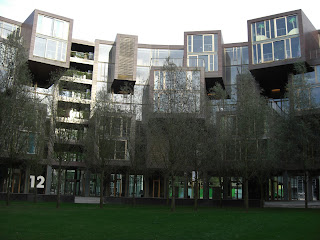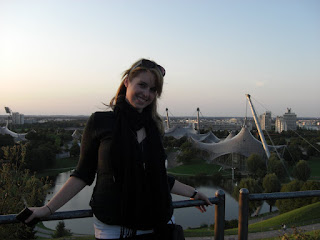We arrived in Copenhagen on Friday afternoon and hit the ground running. My first impression of the city was that it was a mix of Amsterdam and Germany. There were several old brick buildings with copper embellishments, but you could turn the corner and be surrounded by some of the most amazing modern buildings you've seen. It definitely wasn't a rick town, but you could tell they spend their money wisely today. There were windmills all along the coast line, any new building built was designed by a famous architect, and cars were a last priority, bikes were number one. They even designed a new version of a bike for your child to ride in.
Anyways, we had 3 days to see 20 buildings. There were just too many to show you all of them, but here are my favorite. Our first stop on the exploration was to the Black Diamond. I've never heard of the architect, but the building definitely stood out. It was an extension to the public library and designed in two parts separated and put back together by floating walkways. The outside was just ok- I liked how the glossy black facade reflected the passing cars, but the inside was truly spectacular. The views to the harbor were emphasized by a glass wall and long escalators moving slowly towards the window just emphasized the view.
Next we moved on to the Copenhagen University Campus. A new dorm building was just put up a couple years ago in the center of campus. It was a donut shaped building with boxes sticking out here and there. In the center was a large open courtyard surrounded by windows. It looked like such a peaceful place to just sit and work, yet still be in your dorm building. The only downfall was that when you stood in the center of the circular courtyard, there was an echo bouncing off of the walls. I can only imagine at night when there's a couple drunk students walking around- waking up everyone with a courtyard window.
On the same campus was a new music center by Jean Nouvel. He's probably one of France's most famous architects, so it was interesting to see one of his buildings in Denmark. Here in Europe- they design buildings much differently. Instead of using the facade as the water barrier to the interior, they create facades that allow water to fall through. Then, they have a second facade behind this (usually just concrete or sheet metal) that truly blocks out the rain. But this first "rain screen" stops water from hitting the water barrier directly, so it actually decreases the chance for water to enter into the building. Jean Nouvel exaggerated this idea with this concert hall. He created a rain screen in which you can actually walk between the screen and the water barrier facade. This blue "fabric" gave such a dramatic effect and the building just glowed blue from far away at night. The second facade was completely glass and then inside the building he created a third facade with concrete cast in fabric- giving a really interesting texture.
The last part of the day we continued south and found a new area of Copenhagen filling up with residential buildings. There were three buildings in a row all designed by the same architecture firm: BIG, one of my favorite architects. The first of three had dramatic triangular balconies that cantilevered out of the building. It produced a field of balconies and allowed you to connect with several neighbors instead of just 2 on either side. This is the actual building the head architect from BIG lives in! Next to it was a similar building, minus the balconies, that wedged itself next to the previous. Together, these buildings contained over 500 units, of which there are 88 different types of units! He tetris-ed the apartments together to create interesting duplex and tri-plexes- so your apartment consists of several levels to play around with.
The last building was the Mountain Building. In Denmark, there are no mountains, so as BIG says, "If you want to live on a mountain in Denmark, you have to build it yourself." That's exactly what they did. They elevated all of the units gradually and the underneath space becomes all of the parking for the building and a sports center. Unfortunately, they took the mountain too literally and put a picture of Mount Everest covering up the parking- but other than that, this is a completely new way to look at a residential/parking structure.
The following day, we took a 30 minutes train ride over to Sweden- not bad, two countries in one trip! Malmo, Sweden is just across from Copenhagen and has one of Calatrava's best known structures, the Turning Torso. This 50-some story residential structure is the tallest building in all of Malmo- in fact it is so tall you can see it as a blur all the way from Denmark. As we approached the building- it wasn't the greatest of neighborhoods, however you could tell that there were several developments popping up around the Calatrava building. It was just a great view to see this brand new building behind barbed wire.
On our trip back to Denmark, we stopped along the east coast of Denmark to see one of the buildings I've been studying for the past year. It is another building by BIG, a marine youth house and has a very similar roof structure to my fire station I designed first semester of third year. I had written down the instructions on the map- but it was located off the actual map- so we weren't necessarily sure where we were going. We walked to the coast and the area was not one of the best. We saw shacks, boats, and a ended up in an open park. We had no idea where this building was- but- luckily, we had just bought a book of BIG's architecture earlier that day and in that book were pictures of this building. We looked in the background and this building had to be right next to us. We looked through the fence, and sure enough, there it was. But the only way to get there was to climb onto the fence, swing over the cantilever over the ocean, and climb the fence on the other side to land- TWICE. Me- being afraid of heights, was basically crying and I swung across the fence- but- I made it and it was so worth it! We were the only people there- running up and down the roof that reaches all the way from the ground to the top of the building. The city was able to call the building a landscape instead of a building- allowing for the steep accessible roof- and also the reason why it is the only building so close to the water. Definitely, one of the best experiences of my life! I will never forget this building.
The following day was the last- and the least impressive, in all honestly. We walked along the coast in downtown Copenhagen and saw another new residential area. On the way- we ran into BIG's harbor bath- a pool within the harbor. It was one of their first projects- but is an interesting thought of how to bring people into the water.







































































